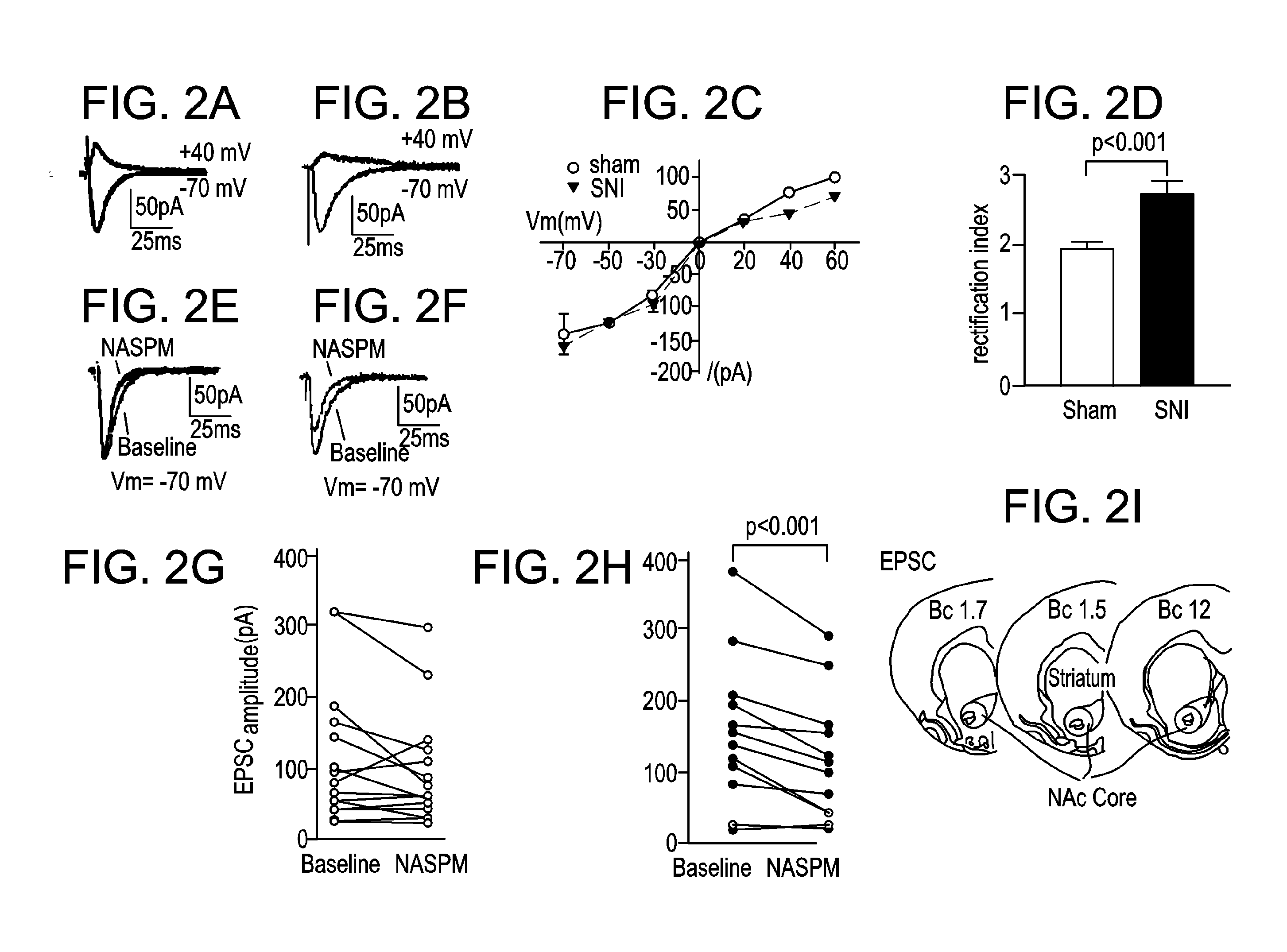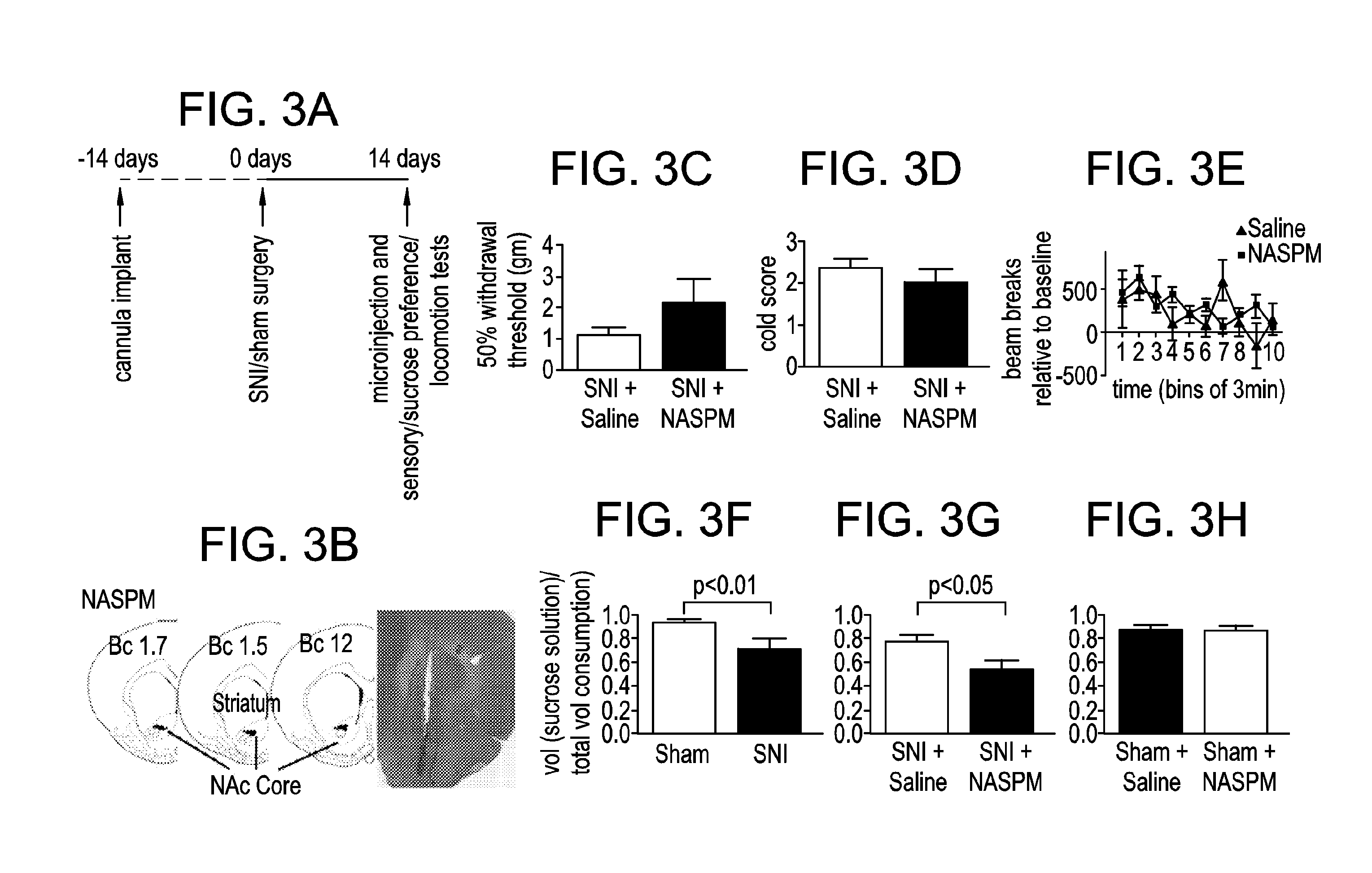Methods of treating depression and pain
a depression and pain technology, applied in the field of mood disorders, can solve the problems of affecting rehabilitation, affecting rehabilitation, and affecting the function of the healthcare system, and achieve the effect of increasing the calcium permeable ampa and reducing symptoms
- Summary
- Abstract
- Description
- Claims
- Application Information
AI Technical Summary
Benefits of technology
Problems solved by technology
Method used
Image
Examples
example 1
[0077]Using the spared nerve injury (SNI) model in rats, GluA1 expression will be shown to be increased at synapses in postoperative pain states. As GluA1 subunits can form CPARs, electrophysiology recordings may be used to determine active CPAR currents. We will determine increases in GluA1 levels at the synapses of NAc neurons and define the time course of this upregulation in spared nerve injury (SNI) model, by examining GluA1 levels in synaptosome, postsynaptic density (PSD) and cell surface fractions and by examining phosphorylation of Ser845, using Western blots.
[0078]Postoperative pain elevates GluA1 subunit levels at synapses of NAc neurons, a process mediated though Ser845 phosphorylation. Similar to rewarding stimuli such as cocaine, pain also activates the NAc (Gear, et al J. Neurosci 1999; 19: 7175-81; Volkow, et al., Arch Neurol 2007; 64: 1575-9; Wise, Nat Rev Neurosci 2004; 5: 483-94; and Brischoux, et al., Proc Natl Acad Sci USA 2009; 106: 4894-9). Thus, it is not sur...
example 2
SNI Model Displays Increased GluA1 Expression
[0080]Western blots were used to compare GluA1 levels in pain and control groups. On POD 14, SNI-treated rats, compared with control, show a statistically significant increase in GluA1 levels in the synaptosomes of their MSNs (FIG. 1C). In contrast, GluA2 levels do not change (FIG. 1D). Synaptosomes are biochemical preparations that isolate the synaptic membrane and proteins and are commonly used to study AMPA receptor trafficking at the synapse. An increase of synaptic GluA1 expression without a concurrent change in the GluA2 level evidences the formation of GluA2-lacking, calcium permeable AMPA receptors (CPARs). We will test functional CPAR currents.
[0081]Pain may induce depression, and depression, rather than pain, then increases GluA1 expression. However, this is unlikely, because other models for depression, such as chronic mild stress model, cause either unchanged or decreased GluA1 levels (Toth, et al., J. Neurochem 2008; 107: 522...
example 3
Demonstrate Increased GluA1 Levels at Synaptic Sites
[0082]Following synaptosome preparations, Western blots will be used to confirm increased GluA1 levels in the SNI model. Synaptosomes contain both pre- and postsynaptic regions. Because AMPA receptors are mostly found at the postsynaptic site, synaptosomes are commonly used to study AMPA receptors. To test the time course of synaptic GluA1 expression, synaptosomes at various postoperative time points will be prepared, followed by Western blot analysis to compare GluA1 and GluA2 levels between pain and control groups in both SNI and PI models.
[0083]Test the Role of Phosphorylation of Ser845 in GluA1 Surface Expression.
[0084]Ser845 phosphorylation is a key step for GluA1 surface transport (He, et al Natl Acad Sci USA 2009; 106: 20033-8). Whether this mechanism is conserved in postoperative pain will be determined by repeating the above experiments in synaptosomes using an antibody specific for pSer845. This will provide mechanistic i...
PUM
| Property | Measurement | Unit |
|---|---|---|
| withdrawal threshold | aaaaa | aaaaa |
| molecular weight | aaaaa | aaaaa |
| molecular weight | aaaaa | aaaaa |
Abstract
Description
Claims
Application Information
 Login to View More
Login to View More - R&D
- Intellectual Property
- Life Sciences
- Materials
- Tech Scout
- Unparalleled Data Quality
- Higher Quality Content
- 60% Fewer Hallucinations
Browse by: Latest US Patents, China's latest patents, Technical Efficacy Thesaurus, Application Domain, Technology Topic, Popular Technical Reports.
© 2025 PatSnap. All rights reserved.Legal|Privacy policy|Modern Slavery Act Transparency Statement|Sitemap|About US| Contact US: help@patsnap.com



